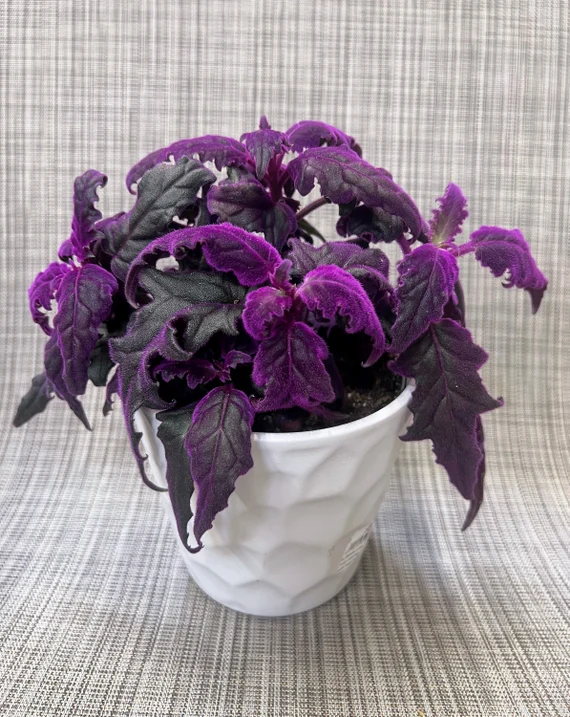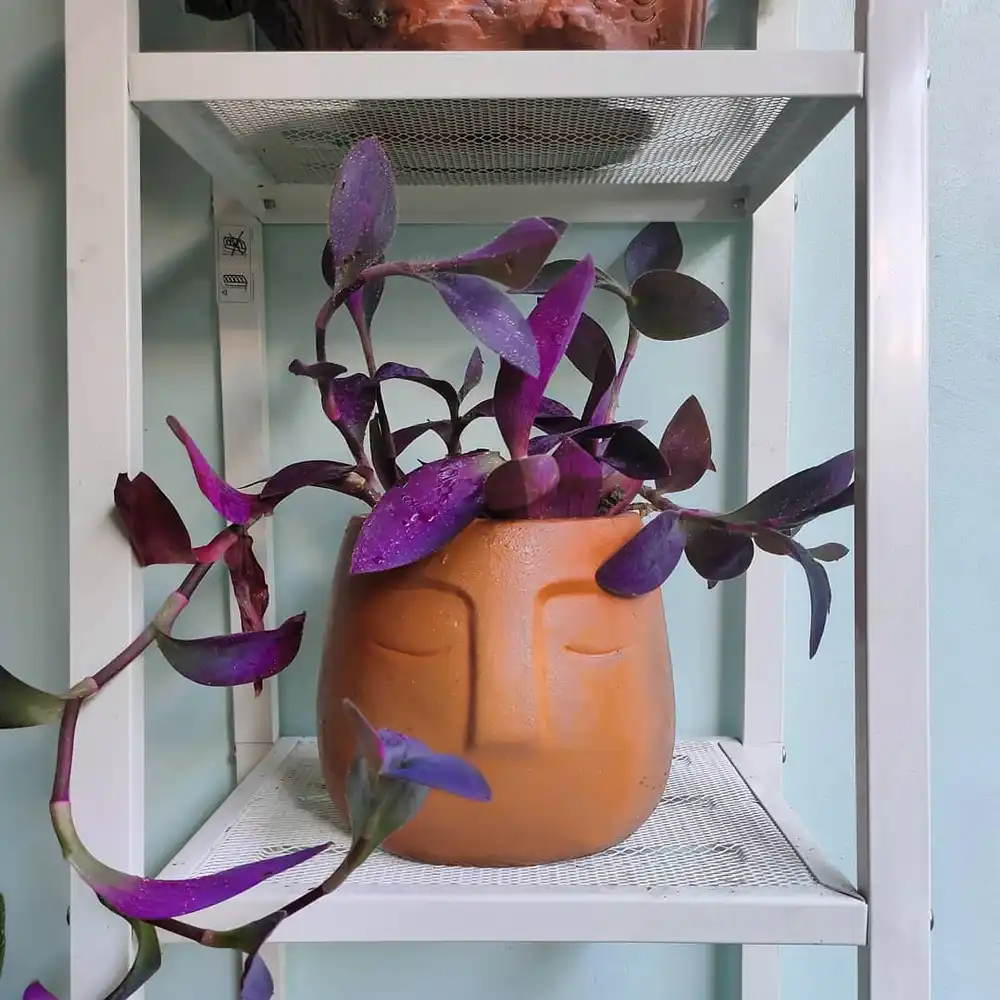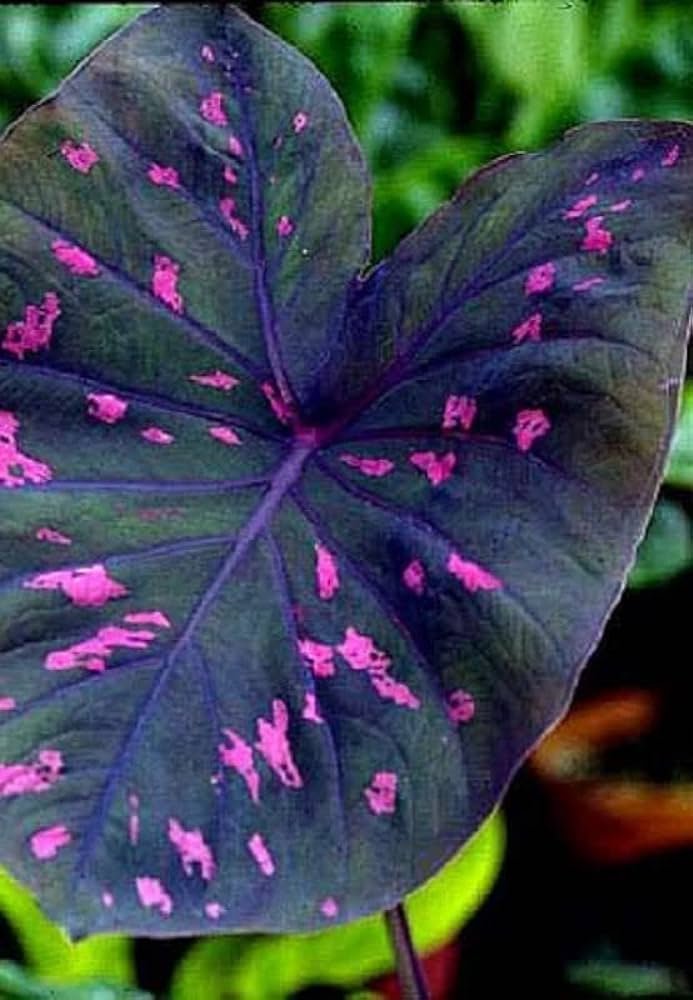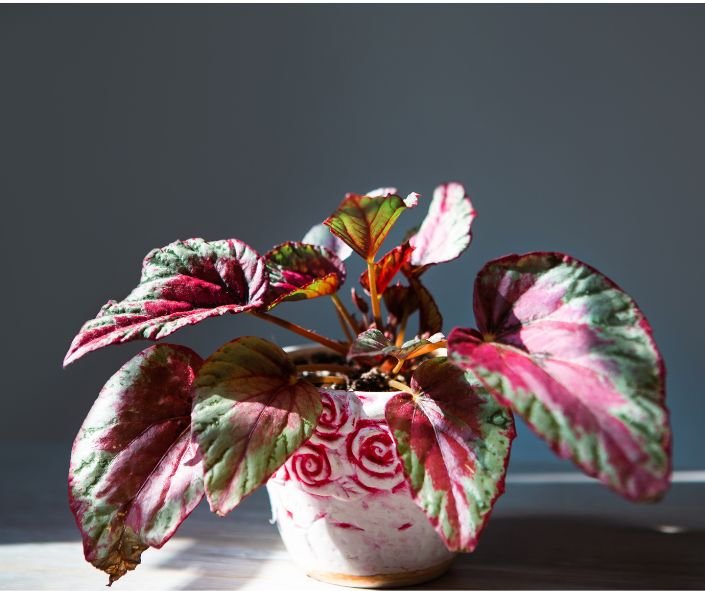Purple houseplants have become increasingly popular in recent years due to their stunning aesthetics and the sense of tranquility they bring to any indoor space. With their vibrant foliage and captivating shades, these plants are the perfect addition to any home or office. Whether you’re a seasoned plant enthusiast or just starting your collection, understanding the appeal of purple houseplants is essential. In this article, we will explore the aesthetics, symbolism, science, and care tips for these fascinating plants. Additionally, we will showcase the top 24 purple houseplants that will undoubtedly enhance the beauty of your surroundings.
Understanding the Appeal of Purple Houseplants
The Aesthetics of Purple Foliage
Purple foliage is renowned for its ability to add a touch of elegance and sophistication to any environment. The deep, rich hues of purples, from velvety dark shades to softer lavenders, create a sense of luxury and tranquility. These plants not only act as focal points but also bring a distinctive charm to any room. The luscious shades of purple can complement various interior design styles, adding depth and visual interest to your space.
Imagine walking into a room adorned with purple houseplants. The vibrant colors immediately catch your eye, drawing you in and creating a sense of intrigue. The velvety texture of the leaves invites you to reach out and touch them, as if they were delicate pieces of art. As you approach closer, you notice the intricate patterns and veins running through the foliage, adding another layer of visual interest. The play of light and shadow on the purple leaves creates a mesmerizing effect, casting a soft glow that enhances the overall ambiance of the room.
Not only do purple houseplants bring aesthetic appeal, but they also have a practical purpose. The rich colors of the foliage can help create a sense of depth in a space, making it appear larger and more spacious. By strategically placing these plants in corners or near windows, you can create a visual illusion that opens up the room, making it feel more inviting and expansive.
The Symbolism of Purple in Nature
Purple has long been associated with royalty, wealth, and power. In nature, it symbolizes wisdom, creativity, and spirituality. By incorporating purple houseplants into your indoor space, you can evoke a sense of peace, balance, and positive energy. These plants can also inspire mindfulness and help create a serene environment where one can relax and unwind after a busy day.
Imagine sitting in a cozy corner of your home, surrounded by purple houseplants. The calming energy they emit envelops you, allowing you to let go of the stresses and worries of the day. The symbolism of purple in nature reminds you to tap into your inner wisdom and creativity, encouraging you to explore new ideas and perspectives. As you gaze at the lush purple foliage, you feel a sense of connection to the natural world, grounding you and bringing a sense of tranquility to your space.
Furthermore, purple houseplants can serve as reminders of the importance of self-care and nurturing oneself. Just as these plants require attention and care to thrive, so do we. By tending to these plants, watering them, and ensuring they receive adequate sunlight, we are reminded of the need to prioritize our own well-being. The act of caring for these purple beauties becomes a meditative practice, allowing us to cultivate a deeper connection with ourselves and the world around us.
Purple Perennials: The Stars of the Garden
The Science Behind Purple Houseplants
Purple houseplants have always fascinated plant enthusiasts with their stunning and vibrant colors. But have you ever wondered what gives them their unique hues? The answer lies in a group of pigments called anthocyanins.
The Role of Anthocyanins
Anthocyanins are pigments responsible for the purple, blue, and red colors found in various plants. These pigments not only provide the vibrant coloration but also serve as protective agents. When it comes to purple houseplants, anthocyanins play a crucial role in their survival and well-being.
One of the primary functions of anthocyanins is to shield the plant tissues from damage caused by excessive light exposure. Just like sunscreen protects our skin from harmful UV rays, anthocyanins act as a natural sunscreen for plants. They absorb and dissipate excess light energy, preventing it from harming the delicate plant cells.
But that’s not all. Anthocyanins also act as antioxidants, defending the plant against harmful free radicals. Free radicals are highly reactive molecules that can cause oxidative stress and damage to the plant’s DNA, proteins, and lipids. By neutralizing these free radicals, anthocyanins help maintain the overall health and vitality of purple houseplants.
Light Requirements for Purple Houseplants
While purple houseplants may appear bold and resilient, they still require specific light conditions to thrive. Understanding their light requirements is essential for ensuring their long-term success.
Most purple foliage plants prefer bright, indirect light. Placing them near a north or east-facing window is ideal as it ensures they receive enough light without being subjected to direct sunlight. Direct sunlight can be too intense for these plants and may lead to leaf burn, where the edges of the leaves become scorched and brown.
Adequate lighting is crucial for maintaining the vividness of their foliage. Without sufficient light, purple houseplants may lose some of their vibrant colors and appear dull. So, if you want to enjoy the full beauty of your purple houseplants, make sure they receive the right amount of light.
15 Plants with Purple and Green Leaves
Top 10 Purple Houseplants to Adorn Your Home
Are you looking to add a touch of color and vibrancy to your indoor garden? Look no further than purple houseplants! These stunning plants not only bring a pop of color to your space but also offer a unique and eye-catching appeal. From velvety leaves to trailing vines, there is a wide variety of purple houseplants to choose from. Let’s explore some of the top choices:
1. Purple Passion Plant
The Purple Passion Plant (Gynura aurantiaca) is a true showstopper. With its velvety leaves in shades of purple and silver, it adds a touch of elegance to any indoor garden. This plant’s unique texture and compact growth habit make it an excellent choice for both small and large spaces. Whether placed on a windowsill or as a centerpiece on a coffee table, the Purple Passion Plant is sure to captivate everyone’s attention.

Originating from Indonesia, this plant thrives in bright, indirect light and prefers well-draining soil. Its striking foliage is not only visually appealing but also serves as a natural air purifier, improving the air quality in your home. Click here for How to care Purple Passion Plant.
2. Persian Shield
If you’re looking for a plant that will truly make a statement, the Persian Shield (Strobilanthes dyerianus) is the perfect choice. With its deep purple foliage and enchanting metallic silver accents, this plant is a true visual delight. Native to Myanmar, the Persian Shield thrives in environments with high humidity, making it an ideal choice for bathrooms or kitchens.

Aside from its stunning appearance, the Persian Shield is also known for its ability to attract beneficial insects such as bees and butterflies. So not only will you be adding a touch of beauty to your home, but you’ll also be supporting local pollinators.
3. Purple Heart Plant
The Purple Heart Plant (Tradescantia pallida) is a popular choice among plant enthusiasts for its trailing vines and heart-shaped leaves. This plant offers an elegant touch to hanging baskets or shelves, cascading down with its vibrant purple foliage. The contrast between the purple leaves and delicate pink flowers creates a truly mesmerizing display.

Native to Mexico, the Purple Heart Plant is a relatively low-maintenance plant, making it perfect for beginners. It thrives in bright, indirect light and prefers well-draining soil. With its ability to tolerate drought conditions, it’s a great choice for those who tend to forget to water their plants.
4. Caladium
Caladiums, native to the lush landscapes of South America, are renowned for their dazzling and vibrant foliage, making them a sought-after choice for both outdoor gardens and interior spaces. Characterized by heart-shaped or arrowhead leaves, these tropical plants boast an array of captivating colors, ranging from lush greens to striking pinks and reds. The intricate patterns on the leaves add an element of sophistication, making Caladiums a delightful addition to any botanical collection.

Thriving in filtered sunlight and well-draining soil, Caladiums are relatively easy to care for. Regular watering is key to maintaining their lush appearance, and they flourish in warm, humid conditions. Whether gracing shaded garden beds or brightening up indoor corners with their tropical flair, Caladiums effortlessly infuse spaces with a touch of exotic charm and natural beauty.
5. Rex Begonia
Rex Begonias (Begonia rex) are nature’s living canvases, celebrated for their stunning and intricate foliage. Hailing from tropical regions of Southeast Asia, these begonias are esteemed for their mesmerizing leaves that come in a rich array of colors, patterns, and textures. The striking leaves often feature a kaleidoscope of hues, including shades of red, pink, silver, and green, making each plant a unique masterpiece.

Cultivating Rex Begonias requires a balance of care and attention. Thriving in indirect light and well-draining soil, these plants are well-suited for indoor environments. Regular watering is essential to keep the soil consistently moist, and high humidity levels contribute to their optimal growth. With their artistic foliage stealing the spotlight, Rex Begonias effortlessly elevate the aesthetic of gardens or indoor spaces, offering a botanical symphony of colors that captivates the eye and ignites the imagination.
Heuchera Palace Purple: A Vibrant Addition to Your Garden
6. Ti Plant
The Ti Plant, scientifically known as Cordyline fruticosa, is a botanical marvel celebrated for its graceful and vibrant foliage. Originating from Southeast Asia and the Pacific, this tropical plant is prized for its long, arching leaves that come in a striking array of colors, including shades of green, pink, red, and purple. With a distinctive and elegant appearance, the Ti Plant adds a touch of tropical splendor to both indoor and outdoor settings.

Cultivating the Ti Plant is a delight for plant enthusiasts. Thriving in bright, indirect light and well-draining soil, it adapts well to various environments. Regular watering is crucial to maintain soil moisture, and it appreciates occasional misting for heightened humidity. Whether showcased as a standalone specimen or incorporated into garden landscapes, the Ti Plant’s lush and vibrant presence brings a sense of exotic beauty, making it a captivating focal point in any botanical arrangement.
7. Wandering Jew
The Wandering Jew (Tradescantia zebrina) is a charismatic trailing plant cherished for its vibrant foliage and resilient nature. Originating from Mexico, this botanical gem is known for its long, cascading vines adorned with striking leaves featuring hues of green, silver, and purple. The distinctive silver stripes across the leaves add a touch of whimsy to its overall appearance, making it a favorite choice for hanging baskets or as a ground cover.

Thriving in bright, indirect light and well-draining soil, the Wandering Jew is an adaptable and low-maintenance companion for plant enthusiasts. Its trailing nature allows it to elegantly drape over containers or surfaces, creating a visually appealing display. Resistant to drought conditions, this plant is forgiving of occasional forgetfulness when it comes to watering. Whether indoors or outdoors, the Wandering Jew brings a dynamic and lively presence to any space, making it a beloved addition to botanical collections.
8. Purple Oxalis
Purple Oxalis (Oxalis triangularis) is a charming and delicate plant, adored for its triangular, deep purple leaves and dainty appearance. Hailing from Brazil, this perennial plant belongs to the wood sorrel family and is a popular choice for both indoor and outdoor gardens. The Purple Oxalis is particularly cherished for its unique characteristic of folding its leaves at night, adding an intriguing dynamic to its overall allure.
Cultivating Purple Oxalis is a delightful experience for plant enthusiasts. Thriving in well-draining soil and partial shade, this plant is well-suited for containers and hanging baskets. Its low-maintenance nature and ability to adapt to different light conditions make it an excellent choice for indoor settings. Regular but moderate watering ensures the soil stays consistently moist. With its distinctive foliage and charming habit of “sleeping” at night, Purple Oxalis brings an element of graceful elegance to any botanical arrangement, making it a captivating addition to both casual and sophisticated plant collections.
9. Ruby’s Necklace
Ruby’s Necklace (Othonna capensis), also known as Little Pickles or String of Rubies, is a charming succulent that captivates with its trailing stems adorned with small, bead-like leaves. Native to South Africa, this plant belongs to the Asteraceae family and is appreciated for its unique, cylindrical foliage that resembles a string of miniature, ruby-colored beads.

Cultivating Ruby’s Necklace is a delightful endeavor for succulent enthusiasts. Perfect for hanging baskets or containers, this trailing succulent thrives in well-draining soil and enjoys bright, indirect light. Its distinctive ruby-red leaves add a pop of color to any setting, creating a visually striking display. As a drought-tolerant plant, Ruby’s Necklace requires infrequent watering, making it an ideal choice for those seeking low-maintenance greenery. With its graceful cascading habit and jewel-toned foliage, this succulent becomes a living necklace that adds dainty elegance to both indoor and outdoor spaces.
10. Purple Sword
The Purple Sword plant, scientifically known as Tradescantia pallida ‘Purpurea,’ is a regal and eye-catching specimen prized for its dramatic, sword-shaped leaves and deep purple hue. Originating from Mexico, this herbaceous perennial is a standout choice for gardeners seeking a bold and majestic presence in their landscapes.

Cultivating the Purple Sword is a rewarding experience for plant enthusiasts. Flourishing in well-draining soil and basking in full to partial sunlight, this plant showcases its vibrant color most intensely under bright light conditions. Its arching, sword-like leaves add a touch of drama to garden beds or containers. Hardy and drought-tolerant, the Purple Sword requires minimal maintenance, making it an excellent choice for both experienced and novice gardeners. With its royal purple foliage and distinctive form, the Purple Sword stands as a symbol of elegance and sophistication in any garden or botanical arrangement.
These are just a few examples of the many purple houseplants available to adorn your home. Whether you’re looking for a statement piece or a subtle touch of color, there is a purple houseplant out there for everyone. So go ahead, bring some purple magic into your indoor garden and enjoy the beauty and tranquility it brings.
Caring for Your Purple Houseplants
Watering Guidelines for Purple Houseplants
Proper watering is crucial for the health of your purple houseplants. These plants generally prefer slightly moist soil, but overwatering can lead to root rot. It is essential to allow the top layer of soil to dry out between watering sessions. Always check the moisture level using your finger or a moisture meter before providing water.
Soil and Fertilizer Needs
For optimal growth, purple houseplants thrive in well-draining soil that retains some moisture without becoming waterlogged. A combination of peat moss, perlite, and compost works well. Fertilize your plants with a balanced, water-soluble fertilizer during their active growth period to ensure they receive essential nutrients.
Pruning and Repotting Tips
Regular pruning helps maintain the shape and vigor of your purple houseplants. Trim any dead or faded foliage to encourage new growth. When repotting, ensure you select a pot that provides adequate drainage and is slightly larger than the current one. Repotting should be done when the plant becomes root-bound or every one to two years.
Troubleshooting Common Problems with Purple Houseplants
Dealing with Pests
Like any other houseplant, purple houseplants can be susceptible to pests such as aphids, mealybugs, and spider mites. Inspect your plants regularly and take immediate action at the first signs of infestation. Use natural or chemical insecticides according to the severity of the problem and ensure you follow the instructions provided.
Addressing Common Diseases
Purple houseplants can experience diseases such as root rot, powdery mildew, or fungal infections. To prevent these issues, avoid overwatering and ensure proper ventilation around the plants. If you suspect a disease, isolate the affected plant and treat it with appropriate fungicides or other remedies recommended for the specific condition.
Resolving Color Fading Issues
If you notice your purple houseplant’s foliage losing its vibrancy, it may indicate insufficient light or nutrient deficiency. Adjust the placement of your plant to provide it with adequate indirect sunlight. Additionally, ensure you are fertilizing your plant regularly to supply it with essential nutrients, which helps maintain the rich colors of the foliage.
With the right care and attention, purple houseplants can thrive and become the highlight of your indoor garden. By understanding their appeal, learning about their science and care needs, and selecting the perfect purple houseplant for your space, you can create a captivating and invigorating environment. So why wait? Bring home the beauty of purple foliage and enjoy the serenity and elegance it brings to your surroundings. Happy gardening!

Pingback: 17 Beautiful Purple Petunia Varieties for Your Garden
Pingback: String of Rubies : How to Plant, Grow, and Care
Pingback: All About Crepe Myrtles: Beautiful Southern Flowering Trees -
Pingback: 20 Easy Flowers for Beginners to Grow - Gardener's School